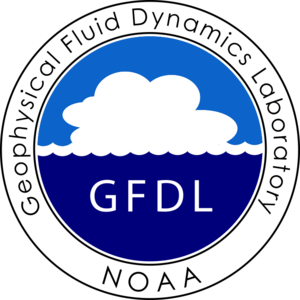Geophysical Fluid Dynamics Laboratory facts for kids
The Geophysical Fluid Dynamics Laboratory (GFDL) is a special science lab. It is part of the National Oceanic and Atmospheric Administration (NOAA). NOAA is a U.S. government agency that studies the Earth's oceans and atmosphere. GFDL is one of seven important research labs within NOAA. Its current director is Venkatachalam Ramaswamy.
GFDL scientists do lots of research. They want to understand how the air and oceans work. They study how these parts of Earth act like complex liquids. Scientists use math and powerful computers to create models. These models help them understand and predict how our planet's systems behave.
GFDL has made many big discoveries. They created the first computer models to study global warming. They also made the first detailed models to predict ocean changes. Plus, they developed models that are good at predicting where hurricanes will go and how strong they will get. Today, much of their work focuses on creating "Earth System Models." These models help us understand how natural events and human actions change our climate.
Contents
What GFDL Has Achieved
GFDL has made many important breakthroughs in understanding Earth's climate and weather:
- They created the first global computer models of the atmosphere. These models helped set up how we predict weather and climate today.
- They made the first computer model that simulated the entire world ocean.
- They helped define key ideas in global warming research. This includes how water vapor affects warming and why polar regions warm faster.
- They developed the first models that link the atmosphere and ocean together. These models were used to simulate global warming for the first time.
- They created a very advanced hurricane model. This model is now used by the NOAA National Weather Service and the Navy to help predict storms.
Science Teams at GFDL
GFDL has about 300 scientists, helpers, and staff. Many come from countries like Britain, India, China, and Japan. The lab is split into different science teams. There's also a big team of computer programmers. They are called the Modeling Systems Division. A large group also helps with computer support.
Atmospheric Physics
Current head: Venkatachalam Ramaswamy
This team uses computer models and observations of Earth. They study how the atmosphere works. They focus on things like greenhouse gases, tiny particles (aerosols), water vapor, and clouds. They want to understand how these things affect weather and climate.
Biogeochemistry, Atmospheric Chemistry, and Ecosystems
Current head: John P. Dunne
This team uses GFDL's Earth system models. They work to understand how physical, chemical, and living systems interact. They study how these parts of Earth affect each other.
Ocean and Cryosphere
Current head: Rong Zhang
This team does important research on oceans and ice (the cryosphere). They study how oceans and ice change. They also look at how these changes affect weather, climate, sea level, and living things. They are building advanced computer models for oceans, sea ice, and land ice.
Seasonal-to-Decadal Variability and Predictability
Current head: Thomas L. Delworth
This team works to better understand climate changes. They look at changes that happen over seasons up to many decades. This includes natural changes in the climate system. It also includes how the climate responds to changes in energy from the sun. They are developing new systems to predict climate over these time scales.
Weather and Climate Dynamics
Current head: Thomas Knutson
This team creates new parts for the next generation of Earth system models. They focus on very detailed atmospheric models. These models can show details as small as 1 to 25 kilometers. They explore new ways to model weather and climate. Their goal is to improve predictions for big events. This includes hurricanes, floods, severe storms, and droughts. They look at predictions from daily weather up to two years ahead.
GFDL's Location and Computers
GFDL is located at Princeton University's Forrestal Campus. This campus is in Princeton, New Jersey.
Since March 2011, GFDL has not had its own supercomputer on site. Instead, they use a very powerful Cray supercomputer. This computer has over 140,000 processor cores. It is located at Oak Ridge National Laboratory in Oak Ridge, Tennessee. Before this, they used eight Silicon Graphics computers. Each of those had 1024 processor cores. GFDL usually updates its computer hardware about every 18 months.
GFDL has been using powerful computers for its models since the 1950s.
Notable Scientists from GFDL
Many important scientists have worked at GFDL, including:
- Joseph Smagorinsky: GFDL's first director.
- Jerry D. Mahlman: GFDL's second director.
- Ants Leetmaa: GFDL's third director.
- Isaac Held
- Kirk Bryan (oceanographer)
- Syukuro Manabe
- Yoshio Kurihara
- Kikuro Miyakoda
- Isidoro Orlanski
- Gareth Williams
- Frank Lipps
- Abraham Oort
See also
- Modular Ocean Model
- GFDL CM2.X


